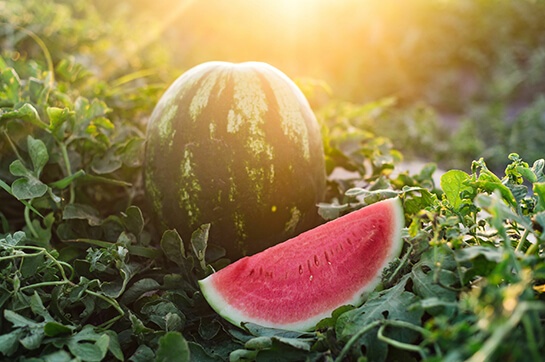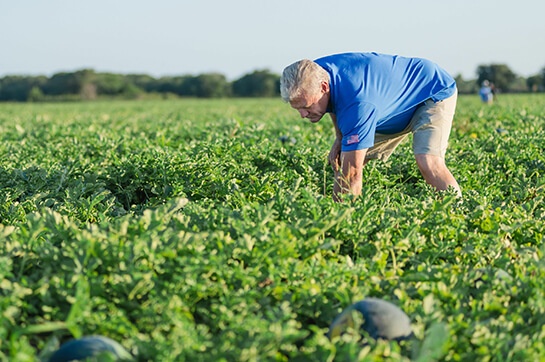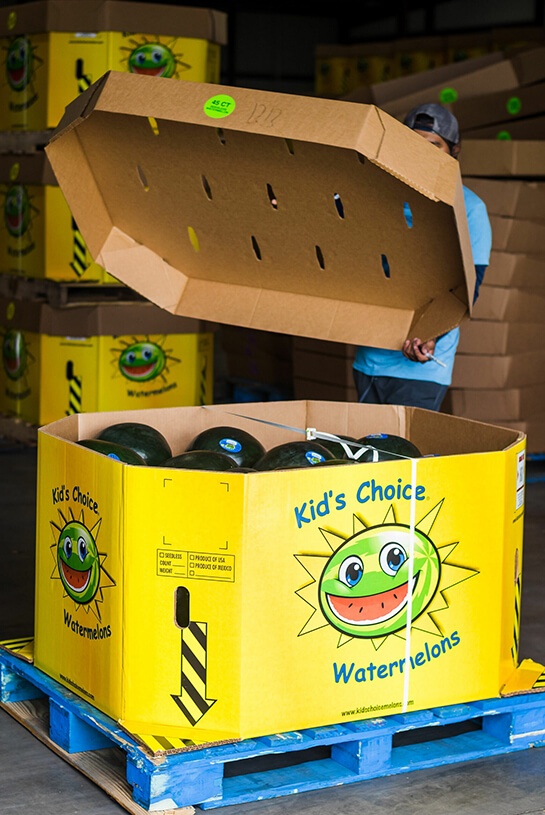
Watermelons are rich in Antioxidants
Lycopene in Watermelons
 Lycopene, which is also abundant in watermelons, has been studied in several trials on humans (this is a peculiarity, since nutrients are generally studied on animals), so we have ample evidence of its health benefits, in particular its protective effect against a growing list of cancers, including prostate cancer, breast cancer, endometrial cancer, lung carcinoma and colorectal carcinoma.
Lycopene, which is also abundant in watermelons, has been studied in several trials on humans (this is a peculiarity, since nutrients are generally studied on animals), so we have ample evidence of its health benefits, in particular its protective effect against a growing list of cancers, including prostate cancer, breast cancer, endometrial cancer, lung carcinoma and colorectal carcinoma.

Seedless Watermelon are NON GMO
Watermelon is a summertime staple, and more prevalently we’re seeing it available in our grocery stores all throughout the year. Delightfully and deliciously, we can have our watermelon as much as we like and as often as we like. Seedless watermelon has made our lives easier, adding to the convenience of taking watermelon on the go as a snack or a refreshing post-workout fuel but also adding to the versatility we now have to play with watermelon in a huge variety of recipes.
But the question is frequently asked (and often incorrectly assumed) about where seedless watermelons came from?
Seedless watermelons were invented over 50 years ago, and they have few or no seeds. When we say seeds, we are talking about mature seeds, the black ones. Oftentimes, the white seed coats where a seed did not fully mature are assumed to be seeds. But this isn’t the case! They are perfectly safe to swallow while eating, and don’t worry – no watermelons will grow in your stomach despite the old wives’ tale.
So, how are seedless watermelons grown? Chromosomes are the building blocks that give characteristics, or traits, to living things including plants and watermelons. Watermelon breeders discovered that crossing a diploid plant (bearing the standard two sets of chromosomes) with a tetraploid plant (having four sets of chromosomes) results in a fruit that produces a triploid seed. (Yes, it has three sets of chromosomes.) This triploid seed is the seed that produces seedless watermelons!
In other words, a seedless watermelon is a sterile hybrid which is created by crossing male pollen for a watermelon, containing 22 chromosomes per cell, with a female watermelon flower with 44 chromosomes per cell. When this seeded fruit matures, the small, white seed coats inside contain 33 chromosomes, rendering it sterile and incapable of producing seeds. This is similar to the mule, produced by crossing a horse with a donkey – simple cross-breeding. And to be clear on the subject, this is not genetic modification. Cross-breeding is two parents and their offspring.
Importantly and interestingly, seedless watermelon still need to be pollinated by their seeded parent, so oftentimes growers will plant seeded and seedless in their field. However, the seeded commercial harvest and retail sales only add up to about 8%, meaning seedless watermelon makes up for 92% of all watermelon sales. Seedless watermelon is hugely popular in the United States and it is here to stay.
Information research/sourced from Watermelon.org
Influence of L-citrulline and watermelon supplementation on vascular function and exercise performance.
Recent findings: There is clear evidence that acute L-citrulline ingestion increases plasma L-arginine, the substrate for endothelial nitric oxide synthesis. However, the subsequent acute improvement in nitric oxide production and mediated vasodilation is inconsistent, which likely explains the inability of acute L-citrulline or watermelon to improve exercise tolerance. Recent studies have shown that chronic L-citrulline supplementation increases nitric oxide synthesis, decreases blood pressure, and may increase peripheral blood flow. These changes are paralleled by improvements in skeletal muscle oxygenation and performance during endurance exercise. The antihypertensive effect of L-citrulline/watermelon supplementation is evident in adults with prehypertension or hypertension, but not in normotensives. However, L-citrulline supplementation may attenuate the blood pressure response to exercise in normotensive men.
Summary: The beneficial vascular effects of L-citrulline/watermelon supplementation may stem from improvements in the L-arginine/nitric oxide pathway. Reductions in resting blood pressure with L-citrulline/watermelon supplementation may have major implications for individuals with prehypertension and hypertension. L-Citrulline supplementation, but not acute ingestion, have shown to improve exercise performance in young healthy adults.
The above article was found on National Library of Medicine website. Influence of L-citrulline and watermelon supplementation on vascular function and exercise performance – PubMed (nih.gov)